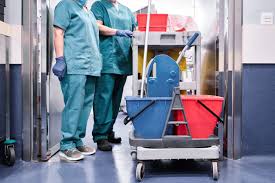Hospital cleanliness is essential for health, hygiene, and patient safety. Although most healthcare facilities in the US follow the recommended basic cleaning procedures, some Maryland hospitals are going the extra mile to ensure that operating rooms, hospital rooms, and common areas are thoroughly cleaned to prevent the spread of pathogens and infection. Last year, 11 hospitals in the Old Line State received top marks from the Leapfrog Group, a nonprofit watchdog group that grades hospitals on how well they prevent accidents and infections. Every six months, the group assigns letter grades to over 3,000 healthcare facilities in the nation. Among those that earned an “A” grade in the second half of 2024 include Maryland hospitals such as the Luminis Health Anne Arundel Medical Center in Annapolis, the MedStar Good Samaritan Hospital in Baltimore, and ChristianaCare Union Hospital in Elktown.
Over the years, many hospitals have shown improvement to keep their facilities clean and orderly. But to protect workers and patients, they need to step up their game to combat serious diseases and harmful bacteria. Here’s how healthcare facilities can elevate their cleaning standards.
Regular Professional Hospital Cleaning
A study has found that housekeeping staff at healthcare facilities are struggling to keep up with stricter cleaning measures since they don’t receive adequate training on hospital disinfection practices. Being unaware of how pathogens can spread in hospital environments can pose significant health risks to patients and workers, so implementing an ongoing and systemic training strategy is a must. As an added layer of protection, hospitals may also consider outsourcing cleaning to experts on an as-needed or regular basis.
For instance, after an infectious disease outbreak, facilities may call on professionals to do hospital floor cleaning, as well as specialized cleaning in operation theaters, emergency rooms, lobbies, and waiting rooms. They may also schedule a professional deep clean every quarter to get rid of bacteria and mold lurking in overlooked areas and hard-to-reach places, such as the ceiling and the outside of windows. Doing so not only ensures a clean hospital, but it also creates a good first impression on patients and visitors.
Prioritize High-Touch Areas
Healthcare professionals know that frequent handwashing can prevent the spread of most diseases in hospital settings. But practicing good hand hygiene doesn’t completely eliminate the risks of getting an infection since bacteria and microorganisms are always present in high-touch areas. These include door knobs, hospital bed rails, remote controls, bed frames, IV poles, blood pressure cuffs, bedside tables, lamps, call bells, and disinfectant and alcohol dispensers, among others.
High frequency cleaning of these areas can reduce exposure to pathogens, so these should be wiped down thoroughly at least once everyday. Detergent and disinfectant-based cleaners can be used to sanitize high-touch areas, and they’re particularly effective when used with a microfiber cloth. According to a study, microfiber cloths are proven to remove up to 98 percent of bacteria even while cleaning with only plain water, so there should be adequate stock of this cleaning tool. It’s recommended to color code cleaning cloths to avoid contamination, so hospital cleaning staff may use blue cloths for high-risk areas while yellow cloths can be used to clean bathrooms.
Use Tech Devices for Sterilization
Incorporating technology into a hospital’s cleaning arsenal can go a long way to effectively sterilize rooms and frequently used equipment. For example, after a thorough clean of hospital rooms, a UV-C device or light can be used to eliminate bacteria, fungi, and germs from surfaces, and it can also remove viruses in the air. To sterilize instruments, an autoclave can be used to kill spores, microbes, and viruses for better infection control. Meanwhile, ultraviolet disinfection robots may be used to clean floors and surfaces to get rid of pathogens in high-risk areas, such as intensive care units and isolation rooms.
Healthcare facilities should always make cleanliness a priority since it’s essential to patient wellness. By outsourcing cleaning, focusing on high-touch areas, and using cutting-edge technology, hospitals in Maryland and in other parts of the country can reduce the risks of bacteria growth in facilities, and improve patient and worker safety.






